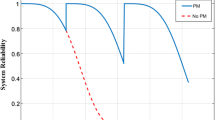Abstract
This paper presents the development of an optimization and a computer-simulation model to evaluate the process plans of a manufacturing center by analyzing the effect of tool failure on system performance. The GPSS/PC simulation program that is used in this study has been built with variables, functions and matrices so that many experiments could be conducted with the model. Sensitivity analysis is presented and the developed model has proven to be useful in determining optimum sequencing of parts for various operating policies.
Similar content being viewed by others
Explore related subjects
Discover the latest articles, news and stories from top researchers in related subjects.References
SuhN.P., New theories of wear and their implications for tool life, Wear 62, 1–20 (1980).
BillatosS.B., et al., A statistical wear-model for certain tool materials with applications to machining, Int. J. Wear 112, 257–71 (1986).
NagasakaK. and HashimotoF., The establishment of tool life equation considering the amount of tool wear, J. Wear 81, 21–31 (1982).
DeVorR.E., AndersonD.L., and ZdeblickW.J., Tool life variations and its influence on the development of tool-life models, ASME Trans. Series B 99, 578 (1977).
Hitomi, K., Nakamura, N., and Inove, S., Reliability analysis of cutting tools, ASME Paper No. 78-WA/PROD-9 (1978).
VysokovskiiE.S., Reliability of cutting tools used on semi-automatic lathes, Russian Eng. J. 46, (6), 46–40 (1966).
VysokovskiiE.S., Reliability of cutting tools in automated production, Russian Eng. J. 50(3), 63–67 (1970).
Billatos, S.B. and Kendall, L.A., An optimal tool changing model for a machining center, ASME-WAM, PED 23, DSC 4, (1986) pp. 245–262.
GertsbakhI.B. and KordonskyKh.B., Models of Failure, Springer-Verlag, New York (1969).
Sheikh, A.K. and Ahmed, M., Estimation of the parameters of the Bernestein population from complete and censored samples, pp. 225–227.
SchriberT.J., Simulation Using GPSS, Wiley, New York (1974).
Schriber, T.J., The use of GPSS/H in modeling typical FMS, Proc. First ORSA/TIMS Special Conf. in FMS, 1984.
CarrieA.S. and BereraD.T.S., Work scheduling in FMS under tool availability constrains, Int. J. Production Res. 24, 1299–1308 (1986).
CampbellH.G., RichardA.D., and MiltonL.S., A heuristic algorithm for the n job, m machine sequencing problem, Management Science 16, 630–637 (1970).
Brooks, G.H. and Charlies, R.W., An algorithm for finding optimal or near optimal solutions for the production scheduling problems, J. Ind. Eng. 16 No. 1 (1965).
Stinson, J.P. and Arthur, W.S., A heuristic programming procedure for sequencing the static flow-shop, Int. J. Production Res. 20 No. 6 (1982).
King, J.R. and Spachir, A.S., Heuristics for flow-shop scheduling, Int. J. Production Res. 18 No. 3 (1980).
Author information
Authors and Affiliations
Rights and permissions
About this article
Cite this article
Abdou, G.H., Billatos, S.B. Simulation and optimization of tool-life in manufacturing centers. J Intell Robot Syst 2, 73–89 (1989). https://doi.org/10.1007/BF00450557
Received:
Accepted:
Issue Date:
DOI: https://doi.org/10.1007/BF00450557




